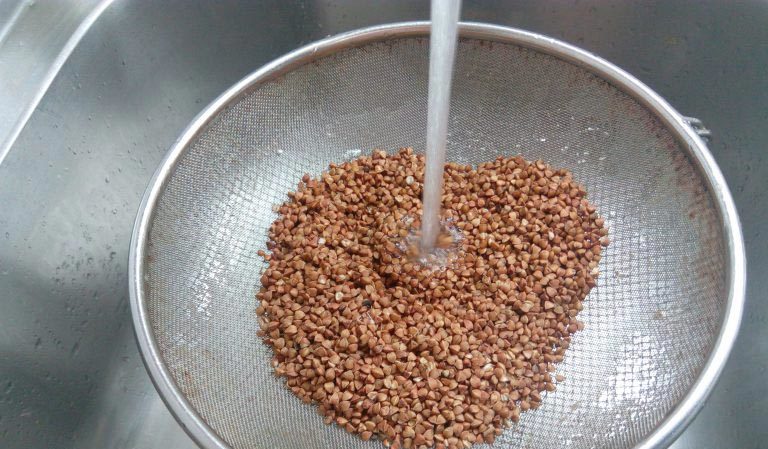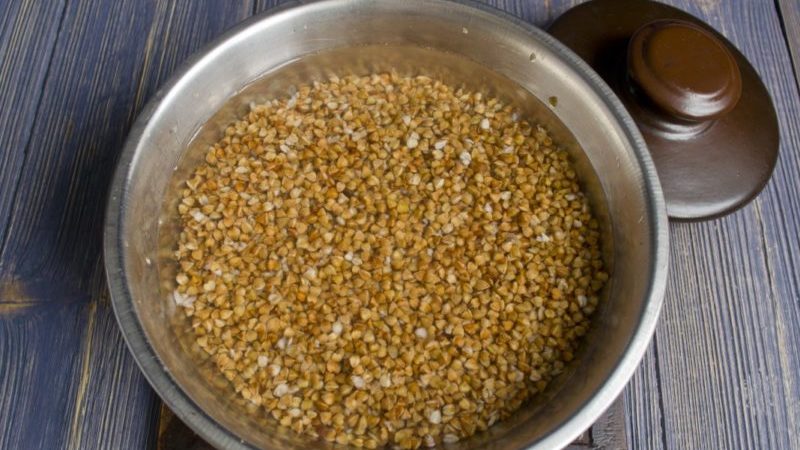We prepare cereals correctly: do you need to wash buckwheat before cooking and how to do it
Cereal dishes are regularly present in the diet of every person. Especially popular is buckwheat, which has a unique composition of nutrients and a high fiber content. To preserve vitamins and minerals during the cooking process, it is important to follow the rules for preparing the product. The article will answer an important question - is it necessary to wash buckwheat before cooking.
The content of the article
Do I need to wash buckwheat before using
Most often, buckwheat is purchased, packaged in transparent cellophane bags. Such packaging weighs 800-900 g and allows you to visually determine the quality and contamination of products. Before cooking, this cereal must be washed several times with cold water.
Why flush

Do not rely entirely on the manufacturer, even if his products are of high quality. Even in expensive packages, you can also find garbage of various origins and low-quality grains.
Washing not only affects the health of the digestive tract, but also the taste, which is significantly different from the taste porridge from unwashed buckwheat. This is easy to check: cook in two versions and try to make sure.
Even cereals intended for baby food can contain various contaminants. In buckwheat of the highest grade, the permissible impurity value is 0.3%, in the third grade - 2 times more. To eliminate them, careful processing is required.
Important! Any kind of buckwheat is washed, regardless of cost.
There is another reason why products are washed before cooking is the removal of phytic acid, which prevents the body from assimilating useful substances: phosphorus, zinc, potassium, magnesium and other minerals. Buckwheat will be less usefulif not rinsed before cooking.
Where is the trash in it
Small rubbish comes across in loose groats and packed groats:
- Broken grains, small particles that do not pass through the sieve in production. Such impurities are not harmful to health, but the cooked porridge will be a viscous consistency.
- Kernels in the fruit shell. Poorly processed cereals can significantly spoil the taste of the finished dish.
- Pebbles, pieces of ore, sand, slag, small earthy lumps, potentially dangerous to the body. Having bitten a small stone while eating, a person can injure a tooth. This type of garbage gets into the process of collecting grains mechanically - it is possible to capture soil particles.
- Organic litter - husks from grains, particles of buckwheat stalks and other closely growing crops (also included during harvesting).
- Black grains of hop dodder are a weedy plant that is found in buckwheat fields.
Groats, especially weighed out, need not only to be washed, but also carefully hand-picked.
Buckwheat preparation instructions

Before cooking, it is sorted out to remove large debris and pebbles. For this:
- They collect the grains in a glass to know how much to cook and pour them onto the table.
- Separate small handfuls from the total mass with the palm of your hand and distribute them in a thin layer over the countertop - this way you can see the fine litter better.
- Unprocessed and empty grains, as well as foreign impurities are removed.
- Peeled cereals are brushed off the table into a container in which buckwheat will be cooked.
It is also convenient to examine the grains in a shallow saucepan with a large diameter, evenly distributing them along the bottom.
How to properly rinse buckwheat before cooking
The cereal cleared of debris is placed in a saucepan, choosing a container with a thick bottom and walls so that the porridge does not burn. Then:
- Place it under the tap and fill it with cold water so that its layer is 2 times the layer of buckwheat.
- The groats are stirred in neat circular motions in one direction, then in the other.
- The remaining small debris immediately floats up, and the grain, as it swells, becomes heavier and settles at the bottom of the pan.
- The dirty water is carefully drained and the cereal is again poured clean. Washing is carried out several times until the water becomes clear.
However, small grains of sand can remain at the bottom of the pan, therefore, for additional cleaning, it is recommended to rinse the buckwheat under running water through a metal sieve.
Before frying
Roasting gives the cereal friability and makes it less boiled, but at the same time buckwheat loses some of its complex carbohydrates. Before calcining the grains, you do not need to rinse, but many housewives do not neglect the procedure - it will relieve the unpleasant taste and sand on the teeth. Processing is carried out by the same method as when cooking buckwheat.
However, when washed, the nucleoli are saturated with moisture and the calcination can partially turn into cooking, after which the grains will become semi-finished. Therefore, many housewives do without washing, but they sort out the cereals without fail.
Before germination
The most useful is considered sprouted groats. Compared to rice, buckwheat contains almost 80 times more antioxidants. "Live" grain promotes an increase in hemoglobin, normalizes the nervous system.
Processing and preparation process:
- Buckwheat is thoroughly washed, floating particles are removed.
- Pour cereal into the container with a layer of 2 cm, fill it with clean water for 3 hours.
- Then pour the cereal into a sieve and rinse under a strong stream of water to get rid of mucus.
- Placed in a container for germination, cover with moistened gauze in several layers, cover with a lid, leaving a gap for air access.
- The container is kept at room temperature (+ 18 ... + 24 ° C) for 12-24 hours.
The appearance of small sprouts indicates that buckwheat is ready for use in its pure form or as an ingredient for salads.

Features of washing green buckwheat
An important stage in any method of preparing a dish from unroasted buckwheat is rinsing with running water.
First, the grains are watered with clean water 2-3 times, then soaked in cool water for 2-3 hours, after which the water is drained. Then they are washed 3-4 more times to completely get rid of mucus that is released when the cereal swells from an excess of moisture. Wash green buckwheat until the water becomes clear.
Do I need to rinse buckwheat in bags
For the convenience of consumers, buckwheat is packed in cooking bags, which are usually packed in 5-6 pcs. in a cardboard box. It happens that the housewives do not have enough time to sort and rinse the buckwheat several times. In this case, these bags are irreplaceable.
The bags are packaged in 80 or 100 g each, the cereals in them are already prepared for consumption and they are not washed, even if the package is opened to add to the soup.
Conclusion
Buckwheat is endowed with wonderful taste and many useful properties that must be preserved in the process of preparing it for use. Regardless of the quality of the product and the method of preparation, buckwheat, like other cereals, is first sorted out, then washed. From this it becomes tastier and healthier. In addition, the risks of ingress of impurities harmful to the body are excluded.